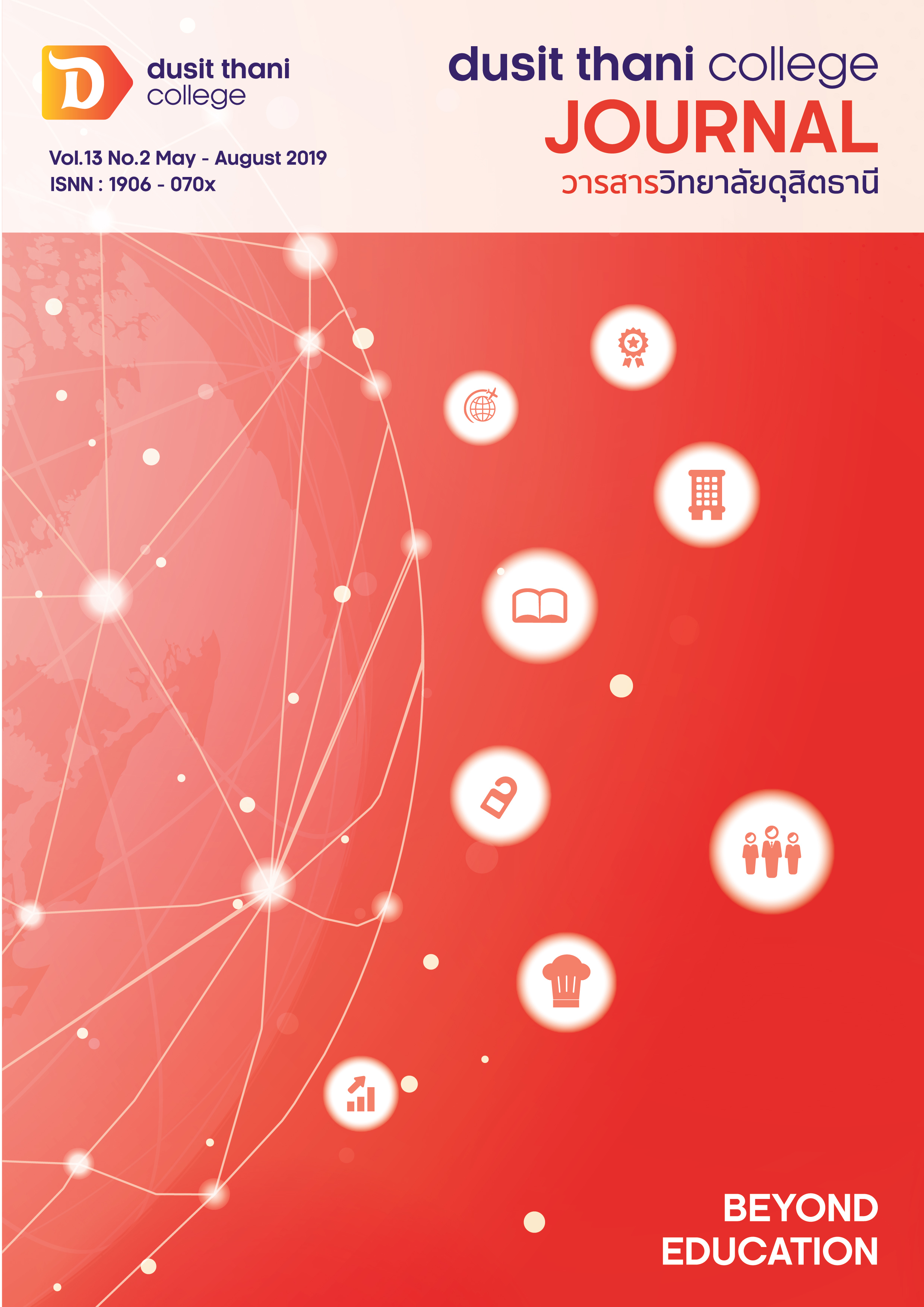การวางแผนและพัฒนาการท่องเที่ยวเชิงสร้างสรรค์สำหรับเมือง ในภูมิภาคเอเชียตะวันออกเฉียงใต้
Main Article Content
บทคัดย่อ
งานวิจัยนี้เป็นการต่อยอดงานวิจัยที่มีอยู่เดิมโดยการศึกษาถึงความซับซ้อนและหลากหลายขององค์ประกอบหลักของเมืองแห่งการท่องเที่ยวเชิงสร้างสรรค์ โดยใช้แบบสอบถาม Delphi เพื่อทำความเข้าใจถึงแนวคิดและวิธีปฏิบัติที่เป็นอยู่ของการท่องเที่ยวเชิงสร้างสรรค์ในภูมิภาคเอเชียตะวันออกเฉียงใต้ วัตถุประสงค์ของงานวิจัยนี้เพื่อ (1) ศึกษาบทบาทของการท่องเที่ยวที่มีต่อการพัฒนาเมือง (2) ระบุแนวคิดของเมืองแห่งการท่องเที่ยวเชิงสร้างสรรค์ในภูมิภาคเอเชียตะวันออกเฉียงใต้ และ (3) เพื่อประเมินความสำคัญของปัจจัยที่มีผลต่อการวางแผนและพัฒนาเมืองให้เป็นเมืองแห่งการท่องเที่ยวเชิงสร้างสรรค์
ผลงานวิจัยนี้ยืนยันว่า การท่องเที่ยวมีบทบาทสำคัญต่อการพัฒนาเมือง การศึกษานี้ได้มีการระบุแนวคิดของเมืองแห่งการท่องเที่ยวเชิงสร้างสรรค์ในภูมิภาคเอเชียตะวันออกเฉียงใต้ และมีการนำเสนอแนวทางในการสร้างสมดุลและความยั่งยืนของสถานที่ ไม่ใช่เพียงเฉพาะการพัฒนาทางด้านเศรษฐกิจ แต่รวมถึงด้านสังคมวัฒนธรรมและสิ่งแวดล้อมด้วย ผลที่ได้รับจากงานวิจัยในครั้งนี้คาดว่าจะมีส่วนช่วยผู้ที่มีส่วนเกี่ยวข้องกับเมืองแห่งการท่องเที่ยวเชิงสร้างสรรค์ทั้งในระดับชาติและระดับท้องถิ่นในการพัฒนาการท่องเที่ยวเชิงสร้างสรรค์ให้ดียิ่งขึ้น และช่วยสนับสนุนให้ผู้มีส่วนเกี่ยวข้องมีส่วนร่วมในกระบวนการการวางแผนและตัดสินใจ อันจะนำมาสู่ความสำเร็จในการพัฒนาเมืองแห่งการท่องเที่ยวเชิงสร้างสรรค์ในภูมิภาคเอเชียตะวันออกเฉียงใต้ในอนาคต
Article Details
นโยบายการพิจารณากลั่นกรองบทความ
- บทความวิจัยและบทความวิชาการทุกเรื่องที่จะได้รับการตีพิมพ์ต้องผ่านการพิจารณากลั่นกรองโดยผู้ทรงคุณวุฒิ (Peer Review) ในสาขาที่เกี่ยวข้อง จำนวน 3 ท่าน/บทความ
- บทความ ข้อความ ภาพประกอบและตารางประกอบที่ลงตีพิมพ์ในวารสารเป็นความคิดเห็นส่วนตัวของผู้เขียน กองบรรณาธิการไม่จำเป็นต้องเห็นด้วยเสมอไป และไม่มีส่วนรับผิดชอบใด ๆ ถือเป็นความรับผิดชอบของผู้เขียนแต่เพียงผู้เดียว
- บทความที่จะได้รับการตีพิมพ์จะต้องไม่เคยตีพิมพ์ เผยแพร่ที่ใดมาก่อน และไม่อยู่ระหว่างการพิจารณาของวารสารฉบับอื่น หากตรวจสอบพบว่ามีการตีพิมพ์ซ้ำซ้อน ถือเป็นความรับผิดชอบของผู้เขียนแต่เพียงผู้เดียว
- บทความใดที่ผู้อ่านเห็นว่าได้มีการลอกเลียนหรือแอบอ้างโดยปราศจากการอ้างอิง หรือทำให้เข้าใจผิดว่าเป็นผลงานของผู้เขียน กรุณาแจ้งให้กองบรรณาธิการวารสารทราบจะเป็นพระคุณยิ่ง
เอกสารอ้างอิง
2. Custer, R.L., Scarcella, J.A., and Stewart, B.R. (1999). The modified Delphi technique:
A rotational modification. Journal of Vocational and Technical Education, 15 (2), 1-10
3. Cyphert, F.R. and Gant, W.L. (1971). The Delphi technique: A case study. Phi Delta Kappan, 52, 272-273.
4. Delbecq, A.L., Van de Ven, A.H., and Gustafson, D.H. (1975). Group Techniques for Program Planning. Glenview, IL: Scott, Foreman, and Co.
5. Fernandes, C. (2011). Cultural planning and creative tourism in an emerging tourist destination. International Journal of Management Cases, Special Issue:
Circle Conference, 629-636 (8).
6. Florida, R. (2002). The Rise of The Creative Class. New York: Basic Books.
7. Hsu, C.C. and Sandford, B.A. (2007). The Delphi technique: Making sense of consensus. Practical Assessment, Research and Evaluation. A Peer-Reviewed Electronic Journal, 12 (10), 1-8.
8. Jacobs, J.M. (1996). Essential assessment criteria for physical education teacher education programs: A Delphi study. Doctoral Dissertation, West Virginia University, Morgantown.
9. Karski, A. (1990). Urban tourism- a key to urban regeneration. The Planner, 76 (13), 15-17.
10. Lorentzen, A. and Hansen, C. J. (2009). The role and transformation of the city in the experience economy: Identifying and exploring research challenges. European Planning Studies, 17(6), 817–827.
11. Ludwig, B. (1997). Predicting the future: Have you considered using Delphi methodology? Journal of Extension, 35 (5), 1-4.
12. OECD (2014), Tourism and the Creative Economy, OECD Studies on Tourism, OECD Publishing.
13. Oh, H., Fiore, A.M. and Jeoung, M. (2007). Measuring experience economy concepts: tourism applications. Journal of Travel Research, 46 (2), 119-131.
14. Okoli, C. and Pawlowski, S.D. (2004). The Delphi method as a research tool: an example, design considerations and applications. Information and Management, 42 (1), 15-29, DOI: http://dx.doi.org/10.1016/j.im.2003.11.002
15. Page, S.J. and Hall, C.M. (2003). Managing Urban Tourism. London: Pearson Education
16. Richards, G. (2009). Creativity and the art of distinction. Paper presented at the conference Creative Spaces for Cultural Tourism, Istanbul, 19-21 November 2009.
17. Richards, G. (2010). Tourism development trajectories- From culture to creativity?.
Encontros Cientificos- Tourism & Management Studies, 6, 9-15.
18. Richards, G. (2011). Creativity and tourism: The state of the art. Annals of Tourism Research, 38 (4), 1225-1253.
19. Richards, G. (2013). Creativity and tourism in the city. Current Issues in Tourism, 2013 Retreived from http://dx.doi.org/10.1080/13683500.2013.783794.
20. Richards, G. and Raymond, C. (2000). Creative Tourism. ATLAS News, 23, 16-20.
21. Spirou, C. (2011). Urban Tourism and Urban Change. Routledge: New York.
22. UNCTAD (2008). Creative Economy Report 2008: The challenge of assessing the creative economy: towards informed policy-making. Retrieved from http://unctad.org/en/docs/ditc20082cer_en.pdf
23. World Bank (2014), Cities alliance annual report 2014 (English). Washington, D.C.:
World Bank Group. Retrieved from http://documents.worldbank.org/curated/en/381881468188332237/Cities-alliance-annual-report-2014
24. World Tourism Organization (2012), Global Report on City Tourism – Cities 2012 Project, UNWTO, Madrid


